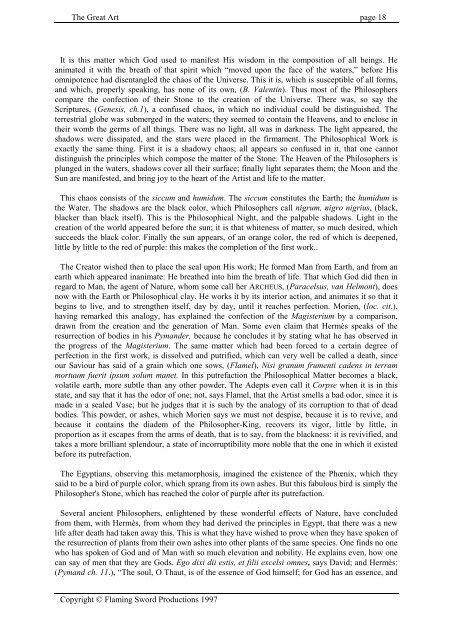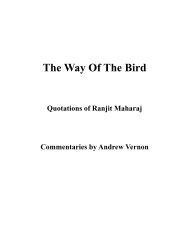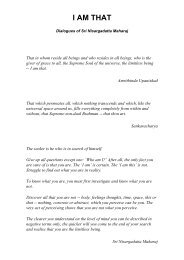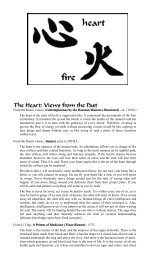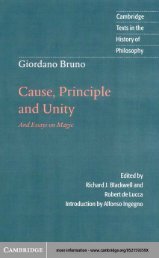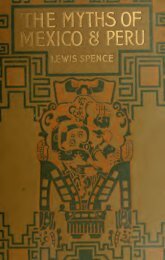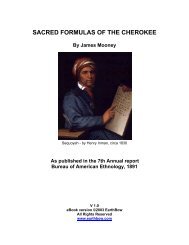The Great Art
Create successful ePaper yourself
Turn your PDF publications into a flip-book with our unique Google optimized e-Paper software.
<strong>The</strong> <strong>Great</strong> <strong>Art</strong> page 18<br />
It is this matter which God used to manifest His wisdom in the composition of all beings. He<br />
animated it with the breath of that spirit which “moved upon the face of the waters,” before His<br />
omnipotence had disentangled the chaos of the Universe. This it is, which is susceptible of all forms,<br />
and which, properly speaking, has none of its own, (B. Valentin). Thus most of the Philosophers<br />
compare the confection of their Stone to the creation of the Universe. <strong>The</strong>re was, so say the<br />
Scriptures, (Genesis, ch.1), a confused chaos, in which no individual could be distinguished. <strong>The</strong><br />
terrestrial globe was submerged in the waters; they seemed to contain the Heavens, and to enclose in<br />
their womb the germs of all things. <strong>The</strong>re was no light, all was in darkness. <strong>The</strong> light appeared, the<br />
shadows were dissipated, and the stars were placed in the firmament. <strong>The</strong> Philosophical Work is<br />
exactly the same thing. First it is a shadowy chaos; all appears so confused in it, that one cannot<br />
distinguish the principles which compose the matter of the Stone. <strong>The</strong> Heaven of the Philosophers is<br />
plunged in the waters, shadows cover all their surface; finally light separates them; the Moon and the<br />
Sun are manifested, and bring joy to the heart of the <strong>Art</strong>ist and life to the matter.<br />
This chaos consists of the siccum and humidum. <strong>The</strong> siccum constitutes the Earth; the humidum is<br />
the Water. <strong>The</strong> shadows are the black color, which Philosophers call nigrum, nigro nigrius, (black,<br />
blacker than black itself). This is the Philosophical Night, and the palpable shadows. Light in the<br />
creation of the world appeared before the sun; it is that whiteness of matter, so much desired, which<br />
succeeds the black color. Finally the sun appears, of an orange color, the red of which is deepened,<br />
little by little to the red of purple: this makes the completion of the first work..<br />
<strong>The</strong> Creator wished then to place the seal upon His work; He formed Man from Earth, and from an<br />
earth which appeared inanimate: He breathed into him the breath of life. That which God did then in<br />
regard to Man, the agent of Nature, whom some call her ARCHEUS, (Paracelsus, van Helmont), does<br />
now with the Earth or Philosophical clay. He works it by its interior action, and animates it so that it<br />
begins to live, and to strengthen itself, day by day, until it reaches perfection. Morien, (loc. cit.),<br />
having remarked this analogy, has explained the confection of the Magisterium by a comparison,<br />
drawn from the creation and the generation of Man. Some even claim that Hermès speaks of the<br />
resurrection of bodies in his Pymander, because he concludes it by stating what he has observed in<br />
the progress of the Magisterium. <strong>The</strong> same matter which had been forced to a certain degree of<br />
perfection in the first work, is dissolved and putrified, which can very well be called a death, since<br />
our Saviour has said of a grain which one sows, (Flamel), Nisi granum frumenti cadens in terram<br />
mortuum fuerit ipsum solum manet. In this putrefaction the Philosophical Matter becomes a black,<br />
volatile earth, more subtle than any other powder. <strong>The</strong> Adepts even call it Corpse when it is in this<br />
state, and say that it has the odor of one; not, says Flamel, that the <strong>Art</strong>ist smells a bad odor, since it is<br />
made in a sealed Vase; but he judges that it is such by the analogy of its corruption to that of dead<br />
bodies. This powder, or ashes, which Morien says we must not despise, because it is to revive, and<br />
because it contains the diadem of the Philosopher-King, recovers its vigor, little by little, in<br />
proportion as it escapes from the arms of death, that is to say, from the blackness: it is revivified, and<br />
takes a more brilliant splendour, a state of incorruptibility more noble that the one in which it existed<br />
before its putrefaction.<br />
<strong>The</strong> Egyptians, observing this metamorphosis, imagined the existence of the Phœnix, which they<br />
said to be a bird of purple color, which sprang from its own ashes. But this fabulous bird is simply the<br />
Philosopher's Stone, which has reached the color of purple after its putrefaction.<br />
Several ancient Philosophers, enlightened by these wonderful effects of Nature, have concluded<br />
from them, with Hermès, from whom they had derived the principles in Egypt, that there was a new<br />
life after death had taken away this. This is what they have wished to prove when they have spoken of<br />
the resurrection of plants from their own ashes into other plants of the same species. One finds no one<br />
who has spoken of God and of Man with so much elevation and nobility. He explains even, how one<br />
can say of men that they are Gods. Ego dixi dii estis, et filii excelsi omnes, says David; and Hermès:<br />
(Pymand ch. 11.), “<strong>The</strong> soul, O Thaut, is of the essence of God himself; for God has an essence, and<br />
Copyright © Flaming Sword Productions 1997


